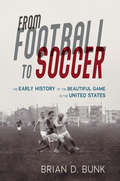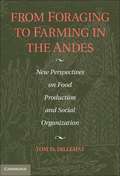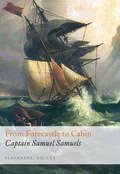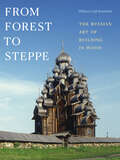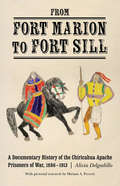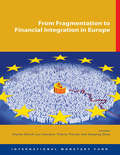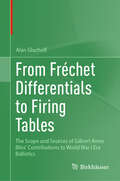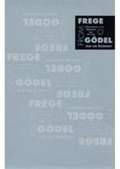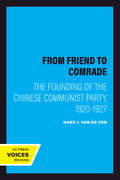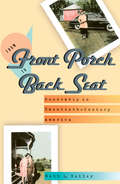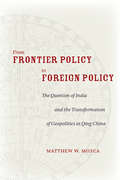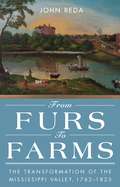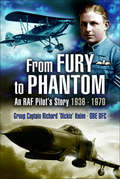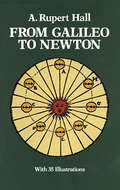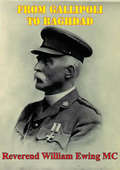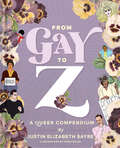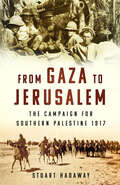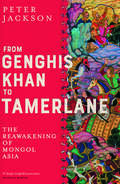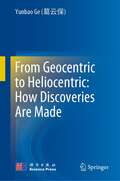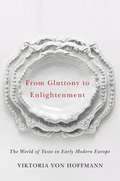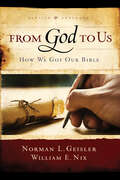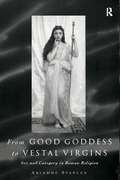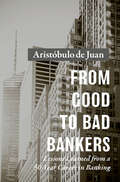- Table View
- List View
From Football to Soccer: The Early History of the Beautiful Game in the United States (Sport and Society #1)
by Brian D. BunkRediscovering soccer's long history in the U.S. Across North America, native peoples and colonists alike played a variety of kicking games long before soccer's emergence in the late 1800s. Brian D. Bunk examines the development and social impact of these sports through the rise of professional soccer after World War I. As he shows, the various games called football gave women an outlet as athletes and encouraged men to form social bonds based on educational experience, occupation, ethnic identity, or military service. Football also followed young people to college as higher education expanded in the nineteenth century. University play, along with the arrival of immigrants from the British Isles, helped spark the creation of organized soccer in the United States—and the beautiful game's transformation into a truly international sport. A multilayered look at one game’s place in American life, From Football to Soccer refutes the notion of the U.S. as a land outside of football history.
From Foraging to Farming in the Andes: New Perspectives on Food Production and Social Organization
by Tom D. DillehayArcheologists have always considered the beginnings of Andean civilization from c. 13,000 to 6,000 years ago to be important in terms of the appearance of domesticated plants and animals, social differentiation, and a sedentary lifestyle, but there is more to this period than just these developments. During this period, the spread of crop production and other technologies, kinship-based labor projects, mound-building and population aggregation formed ever-changing conditions across the Andes. From Foraging to Farming in the Andes proposes a new and more complex model for understanding the transition from hunting and gathering to cultivation. It argues that such developments evolved regionally, were fluid and uneven, and were subject to reversal. This book develops these arguments from a large body of archaeological evidence, collected over 30 years in two valleys in northern Peru, and then places the valleys in the context of recent scholarship studying similar developments around the world.
From Forecastle to Cabin: Seafarers' Voices
by Samuel SamuelsThis is the autobiography of an American who ran away to sea at the age of 11 and charts his rise from the lowliest seaman (berthed under the forecastle) to the command of his own ship and the occupation of the luxurious after cabin. In the course of an action-packed career spanning half a century, he experienced almost all of the vicissitudes of life in the nineteenth-century merchant service: storm and shipwreck, famine and disease, press-gangs and desertion, piracy, violence and mutiny this last, at different times, as both mutineer and victim. Like many a sailor he was often in more danger ashore than afloat, but many of his adventures make excellent stories not least his romantic, but foolhardy rescue of a Christian woman from the harem in Constantinople. In this case the story did not quite follow the script, as she married his accomplice in the rescue. Samuels is best known for his later career, as captain of the packet ship Dreadnought, a ship built especially for him and under his direction. Known as The Wild Boat of the Atlantic in the 1850s this ship was reckoned the fastest vessel on the New YorkLiverpool service, and regularly beat even the steamers on this route. This success was largely down to Samuels hard-driving style as master, and much of the latter part of the book is taken up with the resulting crew troubles, culminating in a full-blown mutiny that he put down with characteristic forcefulness.
From Forest to Steppe: The Russian Art of Building in Wood
by William Craft BrumfieldThroughout Russian history, local craftsmen have shown remarkable skill in fashioning wood into items of daily use, from bridges and street paving to carts and boats to household utensils and combs. Russia has the largest forested zone on the planet, so its architecture was also traditionally made from timber. From homes to churches to forts, Russian buildings are almost all, underneath, constructed with logs, often covered by plank siding or by lathing and plaster.In From Forest to Steppe, renowned scholar and photographer William Craft Brumfield offers a panoramic survey of Russia’s centuries-long heritage of wooden architecture. Lavishly illustrated with more than 400 color photographs, the volume links log-built barns, windmills, houses, and churches in the Far North; Buddhist shrines in the Transbaikal region; and eighteenth-century palaces on the outskirts of Moscow. Brumfield also takes readers to the estate houses of many Russian literary giants, from Chekhov and Tolstoy to Dostoevsky and Pushkin. Spanning thousands of photographed sites, five decades of field work, and seven time zones, Brumfield’s photographs offer compelling evidence of the adaptability of log construction and its ability to transcend class, cultural, and aesthetic boundaries.In the decades since Brumfield began photographing Russian architecture, many of the buildings he has documented have been demolished or abandoned and left to rot at alarming rates. Brumfield observes a contradiction in contemporary Russia: It acknowledges the cultural importance of wooden buildings yet struggles to find and dedicate the resources and solutions needed to save them. A hymn and elegy to the long Russian practice of building with wood, From Forest to Steppe is an unparalleled look into one of the world’s most singular architectural traditions.
From Fort Marion to Fort Sill: A Documentary History of the Chiricahua Apache Prisoners of War, 1886-1913
by Alicia DelgadilloFrom 1886 to 1913, hundreds of Chiricahua Apache men, women, and children lived and died as prisoners of war in Florida, Alabama, and Oklahoma. Their names, faces, and lives have long been forgotten by history, and for nearly one hundred years these individuals have been nothing more than statistics in the history of the United States&’ tumultuous war against the Chiricahua Apache.Based on extensive archival research, From Fort Marion to Fort Sill offers long-overdue documentation of the lives and fate of many of these people. This outstanding reference work provides individual biographies for hundreds of the Chiricahua Apache prisoners of war, including those originally classified as POWs in 1886, infants who lived only a few days, children removed from families and sent to Indian boarding schools, and second-generation POWs who lived well into the twenty-first century. Their biographies are often poignant and revealing, and more than 60 previously unpublished photographs give a further glimpse of their humanity.This masterful documentary work, based on the unpublished research notes of former Fort Sill historian Gillett Griswold, at last brings to light the lives and experiences of hundreds of Chiricahua Apaches whose story has gone untold for too long.
From Fragmentation to Financial Integration in Europe
by Thierry Tressel Charles Enoch Jianping Zhou Luc EveraertA report from the International Monetary Fund.
From Frechet Differentials to Firing Tables: The Scope and Sources of Gilbert Ames Bliss' Contributions to World War I Era Ballistics
by Alan GluchoffThis monograph explores the history of the contribution to ballistics by the American mathematician Gilbert Ames Bliss during World War I. Drawing on the then-evolving calculus of variations, Bliss pioneered a novel technique for solving the problem of differential variations in ballistic trajectory. Called Bliss’ adjoint method, this technique was both hailed and criticized at the time: it was seen as both a triumphant application of pure mathematics to an applied problem and as a complex intrusion of higher mathematics into the jobs of military personnel not particularly interested in these matters. Although he received much praise immediately after the War, the details of Bliss’ work, its furthering of pure mathematical thought, and its absorption into mainstream ballistic work and instruction have never been adequately examined. Gluchoff explores the mathematics of Bliss’ work and the strands from which his technique was developed. He then documents the efforts to make the adjoint method accessible to military officers and the conflicts that emerged as a result both between mathematicians and officers and among mathematicians themselves. The eventual absorption of the adjoint method into range firing table construction is considered by looking at later technical books which incorporate it, and, finally, its influence on the ongoing development of functional calculus is detailed. From Frechet Differentials to Firing Tables will appeal to historians of mathematics, physics, engineering, and warfare, as well as current researchers, professors, and students in these areas.
From Frege to Godel: A Source Book in Mathematical Logic, 1879-1931
by Jean Van HeijenoortThe fundamental texts of the great classical period in modern logic, some of them never before available in English translation, are here gathered together for the first time. Modern logic, heralded by Leibniz, may be said to have been initiated by Boole, De Morgan, and Jevons, but it was the publication in 1879 of Gottlob Frege’s Begriffsschrift that opened a great epoch in the history of logic by presenting, in full-fledged form, the propositional calculus and quantification theory. <p><p> Frege’s book, translated in its entirety, begins the present volume. The emergence of two new fields, set theory and foundations of mathematics, on the borders of logic, mathematics, and philosophy, is depicted by the texts that follow. Peano and Dedekind illustrate the trend that led to Principia Mathematica. Burali-Forti, Cantor, Russell, Richard, and König mark the appearance of the modern paradoxes. Hilbert, Russell, and Zermelo show various ways of overcoming these paradoxes and initiate, respectively, proof theory, the theory of types, and axiomatic set theory. Skolem generalizes Löwenheim’s theorem, and he and Fraenkel amend Zermelo’s axiomatization of set theory, while von Neumann offers a somewhat different system. The controversy between Hubert and Brouwer during the twenties is presented in papers of theirs and in others by Weyl, Bernays, Ackermann, and Kolmogorov. The volume concludes with papers by Herbrand and by Gödel, including the latter’s famous incompleteness paper. <p> Of the forty-five contributions here collected all but five are presented in extenso. Those not originally written in English have been translated with exemplary care and exactness; the translators are themselves mathematical logicians as well as skilled interpreters of sometimes obscure texts. Each paper is introduced by a note that sets it in perspective, explains its importance, and points out difficulties in interpretation. Editorial comments and footnotes are interpolated where needed, and an extensive bibliography is included.
From Friend to Comrade: The Founding of the Chinese Communist Party, 1920-1927
by Hans J. van de VenScholars have long held that the Chinese Communist Party (CCP) was a centralized organization from its founding in 1921. In a departure from that view, From Friend to Comrade demonstrates how the CCP began as a group of study societies, only evolving into a mass Marxist-Leninist party by 1927.Hans J. van de Ven's study is based on party documents of the 1920s that have only recently become available, as well as the writings of a wide range of Chinese communists. He analyzes the party's difficulty in building a cohesive organization firmly rooted in Chinese society. While past scholarship has emphasized the influence of Soviet communism on the CCP, van de Ven stresses the thinking and actions of Chinese communists themselves, placing their struggle in the context of China's political history and highly complex society.
From Front Porch to Back Seat: Courtship in Twentieth-Century America
by Beth L. BaileyFrom gentleman callers to big men on campus, from Coke dates to "parking," From Front Porch to Back Seat is the vivid history of dating in America. In chronicling a dramatic shift in patterns of courtship between the 1920s and the 1960s, Beth Bailey offers a provocative view of how we sought out mates-and of what accounted for our behavior. More than a quarter-century has passed since the dating system Bailey describes here lost its coherence and dominance. Yet the legacy of the system remains a strong part of our culture's attempt to define female and male roles alike.
From Frontier Policy to Foreign Policy: The Question of India and the Transformation of Geopolitics in Qing China
by Matthew W. MoscaBetween the mid-eighteenth and mid-nineteenth centuries, Qing rulers, officials, and scholars fused diverse, fragmented perceptions of foreign territory into one integrated worldview. In the same period, a single "foreign" policy emerged as an alternative to the many localized "frontier" policies hitherto pursued on the coast, in Xinjiang, and in Tibet. By unraveling Chinese, Manchu, and British sources to reveal the information networks used by the Qing empire to gather intelligence about its emerging rival, British India, this book explores China's altered understanding of its place in a global context. Far from being hobbled by a Sinocentric worldview, Qing China's officials and scholars paid close attention to foreign affairs. To meet the growing British threat, they adapted institutional practices and geopolitical assumptions to coordinate a response across their maritime and inland borderlands. In time, the new and more active response to Western imperialism built on this foundation reshaped not only China's diplomacy but also the internal relationship between Beijing and its frontiers.
From Furs to Farms: The Transformation of the Mississippi Valley, 1762–1825
by John RedaThis original study tells the story of the Illinois Country, a collection of French villages that straddled the Mississippi River for nearly a century before it was divided by the treaties that ended the Seven Years' War in the early 1760s. Spain acquired the territory on the west side of the river and Great Britain the territory on the east. After the 1783 Treaty of Paris and the 1803 Louisiana Purchase, the entire region was controlled by the United States, and the white inhabitants were transformed from subjects to citizens. By 1825, Indian claims to the land that had become the states of Illinois and Missouri were nearly all extinguished, and most of the Indians had moved west. John Reda focuses on the people behind the Illinois Country's transformation from a society based on the fur trade between Europeans, Indians, and mixed-race (métis) peoples to one based on the commodification of land and the development of commercial agriculture. Many of these people were white and became active participants in the development of local, state, and federal governmental institutions. But many were Indian or métis people who lost both their lands and livelihoods, or black people who arrived—and remained—in bondage. In From Furs to Farms, Reda rewrites early national American history to include the specific people and places that make the period far more complex and compelling than what is depicted in the standard narrative. This fascinating work will interest historians, students, and general readers of US history and Midwestern studies.
From Fury to Freedom
by Lela Gilbert Raul A. RiesFrom Fury to Freedom is a positive book that will encourage many families to admit some of the most private, even intimate and depressing feelings they have had to endure. The realization that God is the ultimate answer for all their needs will help them to live through these devastating dark days. We cannot deny that our God is a God of miracles. He took Raul from the pits of hell, from the cocoon of despair, insecurity, fear, hate, and self-destruction, into the most wonderful healing—SALVATION; the healing of his soul and spirit. Raul is evidence of how God's grace can spare the life of a young boy and nurture him into manhood. Jesus cradled Raul's head in His bosom, and kissed away his pain. He gave him the direction and love for which he was desperately searching.
From Fury to Phantom: An RAF Pilot's Story, 1936–1970
by Richard Haine"Richard 'Dickie' Haine first went solo in a de Havilland Gipsy Moth during August 1935, after only one week of tuition. He joined the RAF shortly afterwards as a Direct Entry Sergeant Pilot and left the service in 1970 as a Group Captain, OBE, DFC. During his long career he flew an extraordinary variety of aircraft types, starting with small biplanes that were designed upon the philosophy gained during World War I and finishing with Britain's V Bomber force and American-designed fighters at the very edge of space.His first posting was with No 25 Squadron flying Hawker Demons and Gloster Gladiators during 1936 until the unit was re-equipped with Bristol Blenheims and undertook a night-fighter role. These were difficult days during which the primitive radar system made it all but impossible to locate incoming enemy aircraft, but the squadron were also sent on several offensive missions over the recently invaded European countries. Haine was lucky to escape when his aircraft was brought down and crash-landed on a small Dutch island after an abortive raid on German occupied Walhaven airfield. After a hazardous journey on foot through the increasingly threatened lowlands he escaped on a RN Frigate. During the Battle of Britain he continued in the night-fighting role flying from Manston in Kent.Now a Commissioned officer, he was given command of No 96 Squadron, flying Boulton Paul Defiants in the night defense of the industrial heartland of England. The, after a spell as a Staff Officer at Bentley Priory, he took command of No 448 (New Zealand Squadron) who were equipped with the superlative de Havilland Mosquito. During this period the squadron had an enviable score sheet in downing enemy aircraft during many night operations. In 1945 the author was dispatched by ship to take charge of a newly formed wing to aid those forces still at war with Japan. However, whilst still at sea, the war ended and Haine found himself in Hong Kong with the task of getting Kai Tak airport operational immediately after its liberation.His post-war flying was heavily involved in the development of jet-powered fighters and sophisticated new weaponry. He spent a long period as Wing Commander in Habbinya and Akrotiri and ended his career training the navigators of the V-Bomber nuclear Force."
From Galileo to Newton
by A. Rupert HallThe near century (1630-1720) that separates the important astronomical findings of Galileo Galilei (1564-1642) and the vastly influential mathematical work of Sir Isaac Newton (1642-1727) represents a pivotal stage of transition in the history of science. As a result of the raging intellectual battle between tradition and innovation that began in the fifteenth century, science was penetrated by a new outlook that placed emphasis on experiment and observation. Galileo showed the promise of its new methods of discovery; Newton brought out their full force and effect. Galileo suffered from an attempt to censure scientific inquiry; Newton showed how science could discover the universal laws of nature. The triumph of this new outlook marked the birth of modern science.From Galileo to Newton describes those new patterns of thought that emerged during this time of great excitement and widespread controversy. It discusses the discoveries revealed by telescope and microscope in the work of Huygens and Leeuwenhoek, and the new speculations to which these gave rise; Boyle's attempts to include chemical experiments within a rational theory of matter, and those begun by Descartes to explain the workings of the body on the basis of chemical and physical principles; and the revolutionary ideas in astronomy that generated the transition from the Ptolemaic concept of the universe to the Copernican and the subsequent acceptance of the heliostatic system.Since the dawn of civilization man has tried to find logic in the mysterious and order in the chaotic. From Galileo to Newton will appeal to anyone who wants to know what modern science is all about and how it came into being. One of the foremost authorities on the history of science, Professor Hall is not only a scholar of great learning and originality, he also writes with clarity, liveliness, and a keen biographical sense.
From Gallipoli To Baghdad [Illustrated Edition]
by Reverend William Ewing MCIncludes Gallipoli Campaign Map and Illustrations Pack -71 photos and 31 maps of the campaign spanning the entire period of hostilities.The epic story of a Chaplain attached to the 4th Battalion the Royal Scots during the First World War; ministering to his flock amid the shot and shell of the bloody failures at Gallipoli and onward to the victorious march to Baghdad."British (Scottish) author and clergyman. He was born at Corsock, near Kircudbright in the South-West of Scotland, the second son of John Ewing and Marion McCulloch, and was educated at the Universities of Glasgow and Leipzig. Following his ordination, he served as a minister in Palestine, Birmingham, and his native Scotland, He was married twice, both times to women from Hartlepool in County Durham; firstly, in 1888, to Margaret Jane Park, and, secondly, in 1896, to Elizabeth Mary Black, with whom he had one son and two daughters. In 1910, he was appointed Territorial Chaplain to the 4th. Battalion of the Royal Scots Regiment, and served as Chaplain to the Forces on Gallipoli for eight months including the evacuation, for which he was awarded the Military Cross and was mentioned in despatches. Later in the War, he was at the Suez Canal for three months and in Mesopotamia for a year, in the course of which which he was wounded at Baghdad and, again, mentioned in despatches, and a third such mention occurred with the Egyptian Expeditionary Force in the advance from Gaza to Jerusalem. After the Armistice, he became the Chaplain of St. Andrew's Church in Jerusalem. He was the author of seven books, most of which, such as "Arab and Druze at Home" (1907) and "Cedar and Palm" were concerned with the Middle East. The final line of his inscription reads, "A comforter of many.""-Memorial
From Gay to Z: A Queer Compendium
by Justin Elizabeth SayreThis illustrated compendium celebrates LGBTQIA+ history and culture, written by and according to culture icon Justin Elizabeth Sayre!Based on Sayre's five-part show in New York City, From Gay to Z is a humorous collection of the rich legacy of gay culture, told through the letters of the alphabet. From ABBA to addiction, hair and makeup to HIV, Fannie Flagg to fierce, Sayre offers their own perspective on the things that have influenced gay culture today, including iconic figures, historical moments, ongoing issues in the LGBTQIA+ community, and everything in between. As gay culture is always evolving and different for everyone, this book does not serve as a definitive guide—instead, Sayre encourages readers to use this knowledge to reflect on the things that have informed their personal identities. Engagingly written and beautifully designed, From Gay to Z is a distinctive and dynamic look at gay culture for LGBTQIA+ readers everywhere.STRONG VOICE AND ENGAGING CONTENT: Sayre's writing is lively, engaging, and rich. The entries have their own style and contain humorous anecdotes, facts, commentary, and more—all told through Sayre's animated yet authoritative voice.BELOVED, WELL-KNOWN AUTHOR: Sayre is active and well-known in the LGBTQIA+ community and beyond. They've been recognized as one of "LA's 16 Most Talented LGBT Comics" by Frontiers Magazine, and their debut comedy album, The Gay Agenda, was named one of 2016's "Best Things in Comedy" by The Comedy Bureau. They host their own podcast, Sparkle & Circulate, where they interview performers, writers, and other creative minds of the LGBTQIA+ community. As an activist, Justin's charity benefit show, "Night of a Thousand Judys," raises money for the Ali Forney Center for Homeless LGBTQIA+ youth and is now in its 7th year.Perfect for:• LGBTQIA+ people of all ages• Fans of Trixie and Katya's Guide to Modern Womanhood• Those looking for a birthday or holiday gift for their LGBTQIA+ friends and family
From Gaza to Jerusalem: The Campaign for Southern Palestine 1917
by Stuart HadawayThe Palestine campaign of 1917 saw Britain’s armed forces rise from defeat to achieve stunning victory. After two failed attempts in the spring, at the end of the year they broke through the Ottoman line with an innovative mixture of old and new technology and tactics, and managed to advance over 50 miles, from Gaza to Jerusalem, in only two months. As well as discussions of military strategy, Stuart Hadaway’s gripping narrative of the campaign gives a broad account of the men on both sides who lived and fought in the harsh desert conditions of Palestine, facing not only brave and determined enemies, but also the environment itself: heat, disease and an ever-present thirst.Involving Ottoman, ANZAC, British and Arab forces, the campaign saw great empires manoeuvring for the coveted Holy Land. It was Britain’s victory in 1917, however, that redrew the maps of the Middle East and shaped the political climate for the century to come.
From Genghis Khan to Tamerlane: The Reawakening of Mongol Asia
by Peter Jackson"A masterwork"—William Dalrymple, Financial Times "A landmark publication"—Noel Malcom, The TelegraphAn epic account of how a new world order under Tamerlane was born out of the decline of the Mongol Empire By the mid-fourteenth century, the world empire founded by Genghis Khan was in crisis. The Mongol Ilkhanate had ended in Iran and Iraq, China&’s Mongol rulers were threatened by the native Ming, and the Golden Horde and the Central Asian Mongols were prey to internal discord. Into this void moved the warlord Tamerlane, the last major conqueror to emerge from Inner Asia. In this authoritative account, Peter Jackson traces Tamerlane&’s rise to power against the backdrop of the decline of Mongol rule. Jackson argues that Tamerlane, a keen exponent of Mongol custom and tradition, operated in Genghis Khan&’s shadow and took care to draw parallels between himself and his great precursor. But, as a Muslim, Tamerlane drew on Islamic traditions, and his waging of wars in the name of jihad, whether sincere or not, had a more powerful impact than those of any Muslim Mongol ruler before him.
From Geocentric to Heliocentric: How Discoveries Are Made
by Yunbao Ge (葛云保)Has anyone ever seen with their own eyes that the Earth goes around the sun? Even to this day, no one has. However, 500 and even 2000 years ago, some astronomers managed to point out that this is the case. At that time, people’s range of activities was strictly confined, the technology and tools used were extremely primitive, and many of the mathematical methods used today had not been developed. How did those astronomers make and verify this discovery? This book explains this exciting demonstration process. It enables anyone with a basic junior-high-school knowledge of geometry and a certain degree of spatial imagination to understand this and other interesting discoveries in the solar system. By demonstrating this interesting process, the book not only satisfies readers' curiosity using the simplest mathematics, but also inspires them to explore the new and unknown world.
From Gluttony to Enlightenment: The World of Taste in Early Modern Europe
by Viktoria Von HoffmannScorned since antiquity as low and animal, the sense of taste is celebrated today as an ally of joy, a source of adventure, and an arena for pursuing sophistication. The French exalted taste as an entrée to ecstasy, and revolutionized their cuisine and language to express this new way of engaging with the world. Viktoria von Hoffmann explores four kinds of early modern texts--culinary, medical, religious, and philosophical--to follow taste's ascent from the sinful to the beautiful. Combining food studies and sensory history, she takes readers on an odyssey that redefined a fundamental human experience. Scholars and cooks rediscovered a vast array of ways to prepare and present foods. Far-sailing fleets returned to Europe bursting with new vegetables, exotic fruits, and pungent spices. Hosts refined notions of hospitality in the home while philosophers pondered the body and its perceptions. As von Hoffmann shows, these labors produced a sea change in perception and thought, one that moved taste from the base realm of the tongue to the ethereal heights of aesthetics.
From God To Us Revised and Expanded: How We Got Our Bible
by Norman L Geisler William E. NixWhere did the Bible come from? How do we know the right books are in the Bible? Does the Bible contain errors? What are the oldest copies we have of the Bible? How do we know that the Bible hasn't been changed over the years? Why are there so many translations of the Bible, and which one should I use? These are just some of the important questions about the Bible that are discussed in this book. Understanding basic facts about the origin of the Bible is essential for every Christian, but it can also be confusing and difficult. Here, two well-known scholars, authors of a more technical book, A General Introduction to the Bible, explain simply and clearly these basic facts. Inspiration, the biblical canon, major manuscripts, textual criticism, early translations, and modern versions are some of the major topics discussed. Careful explanations of important points are given throughout, as the entire field of biblical introduction is covered. Completely updated and revised edition of the 1974 work (more than 78,000 copies sold). Helpful charts have been added, along with an index of subjects, persons, and Scripture. This book is ideally suited for Bible students, pastors, and professors. While writing for readers without previous training, the authors do not gloss over difficult and complex issues when they arise. The nature of inspiration, the extent of the canon, and the usefulness of modern versions are all clearly discussed. The authors write: "The chain of communication from God to us is strong. It has several solid links: inspiration, collection, transmission, and translations. The strength of these links provide the contemporary Christian with the moral certitude that the Spirit-inspired original text of Scripture has been providentially preserved by God so that for all practical purposes the Bible in our hands is the infallible and inerrant word of God."
From God To Us Revised and Expanded: How We Got Our Bible
by Norman L Geisler William E. NixWhere did the Bible come from? How do we know the right books are in the Bible? Does the Bible contain errors? What are the oldest copies we have of the Bible? How do we know that the Bible hasn't been changed over the years? Why are there so many translations of the Bible, and which one should I use? These are just some of the important questions about the Bible that are discussed in this book. Understanding basic facts about the origin of the Bible is essential for every Christian, but it can also be confusing and difficult. Here, two well-known scholars, authors of a more technical book, A General Introduction to the Bible, explain simply and clearly these basic facts. Inspiration, the biblical canon, major manuscripts, textual criticism, early translations, and modern versions are some of the major topics discussed. Careful explanations of important points are given throughout, as the entire field of biblical introduction is covered. Completely updated and revised edition of the 1974 work (more than 78,000 copies sold). Helpful charts have been added, along with an index of subjects, persons, and Scripture. This book is ideally suited for Bible students, pastors, and professors. While writing for readers without previous training, the authors do not gloss over difficult and complex issues when they arise. The nature of inspiration, the extent of the canon, and the usefulness of modern versions are all clearly discussed. The authors write: "The chain of communication from God to us is strong. It has several solid links: inspiration, collection, transmission, and translations. The strength of these links provide the contemporary Christian with the moral certitude that the Spirit-inspired original text of Scripture has been providentially preserved by God so that for all practical purposes the Bible in our hands is the infallible and inerrant word of God."
From Good Goddess to Vestal Virgins: Sex and Category in Roman Religion
by Ariadne StaplesThe role of women in Roman culture and society was a paradoxical one. On the one hand they enjoyed social, material and financial independence and on the other hand they were denied basic constitutional rights. Roman history is not short of powerful female figures, such as Agrippina and Livia, yet their power stemmed from their associations with great men and was not officially recognised.Ariadne Staples' book examines how women in Rome were perceived both by themselves and by men through women's participation in Roman religion, as Roman religious ritual provided the single public arena where women played a significant formal role. From Good Goddess to Vestal Virgins argues that the ritual roles played out by women were vital in defining them sexually and that these sexually defined categories spilled over into other aspects of Roman culture, including political activity.Ariadne Staples provides an arresting and original analysis of the role of women in Roman society, which challenges traditionally held views and provokes further questions.
From Good to Bad Bankers: Lessons Learned from a 50-Year Career in Banking
by Aristóbulo de JuanBankers are administrators of other people’s money, and they are responsible both to their depositors and to other stakeholders. Human nature being what it is, however, they sometimes fall prey to overweening ambition, coming to see themselves as the rightful beneficiaries of the moneys entrusted to them. This can lead them to make poor lending decisions and engage in risky practices, eventually moving on to cosmetic accounting and the concealment of problems, speculation and even outright fraud.Supervisors are there to prevent such behaviour, of course. They are responsible to government and the general public alike for the stability of the financial system, the proper allocation of financial resources by the banks and the protection of depositors and creditors. Their responsibility is, then, subsidiary to that of the bankers themselves.Where supervision is lax and ineffective, however, it encourages bad management by bankers, creating a vicious circle that eventually leads to financial crises, which has most often to be cured using tax-payers’ money. Of course, it also hurts the broader economy. That is why the inseparable trio of regulation, supervision and resolution must exist.In this collection of his writings over a period of some 50 years, Aristóbulo de Juan describes the causes, characteristics and consequences of financial crises based on his own experience as a central banker, world bank expert and consultant spanning a career of more than 55 years.In a nutshell, the papers brought together in this book recount circumstances that have always plagued banking, and that are only too likely to recur in the future.
